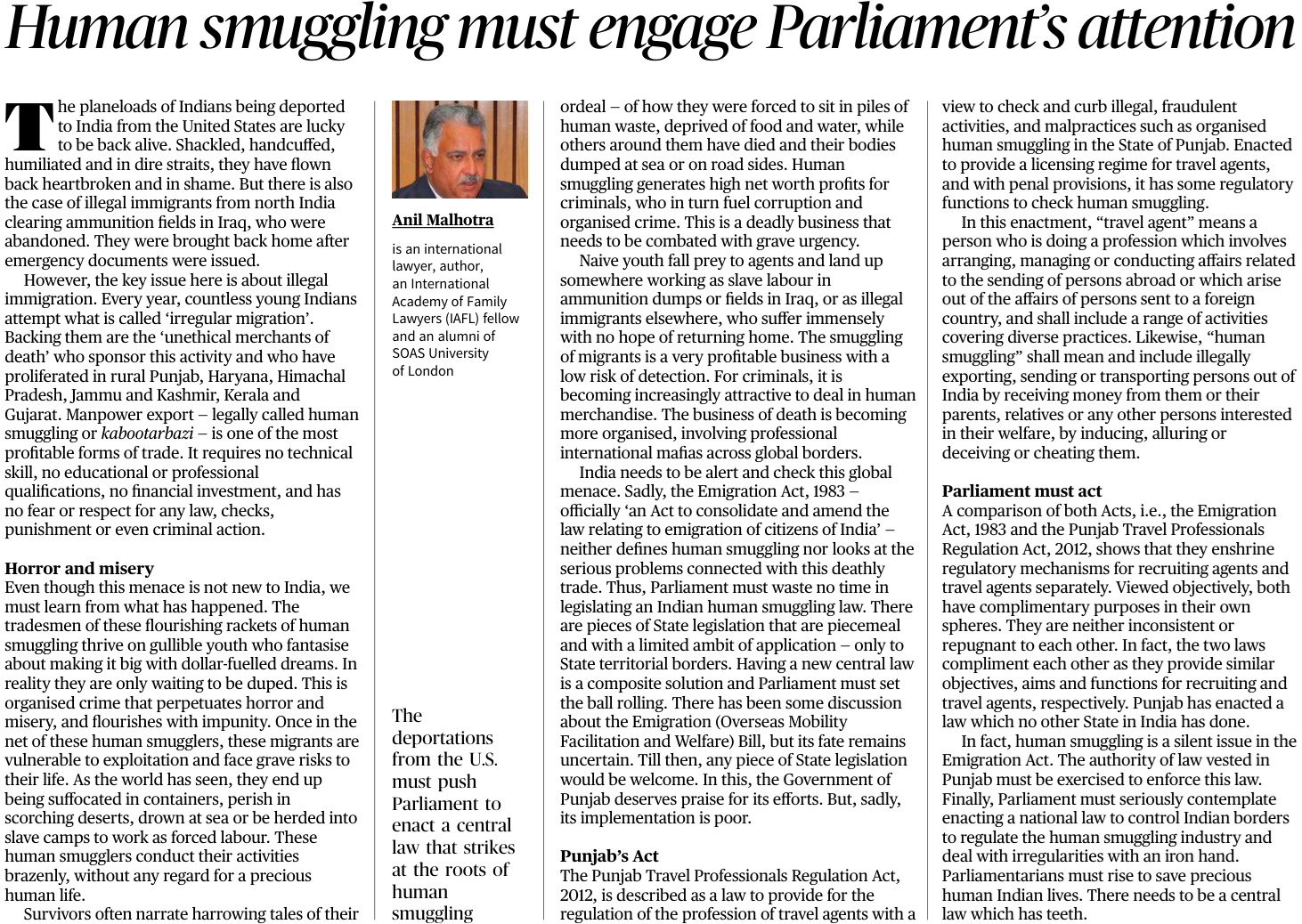2. Tackling Human Smuggling: The Need for Legislative Action
Introduction
- Human smuggling is a grave issue involving illegal migration and exploitation of vulnerable individuals.
- India has witnessed the deportation of illegal immigrants, highlighting the urgency to curb this menace.
- The practice thrives due to lack of stringent laws, making it a profitable trade for criminals.
Causes of Human Smuggling
- Economic Distress: Lack of employment opportunities forces people to seek illegal migration.
- Lack of Awareness: Many individuals are deceived by agents with false promises of a better life.
- Weak Legal Framework: The outdated Emigration Act, 1983, does not effectively address human smuggling.
- Organized Crime: Smuggling is controlled by professional mafias operating across borders.
Consequences of Human Smuggling
- Human Rights Violations: Migrants face abuse, forced labor, and life-threatening situations.
- Economic Loss: Families lose money by paying traffickers with no legal recourse.
- National Security Threat: Illegal migration can facilitate infiltration by anti-national elements.
- Corruption and Organized Crime: Smuggling fuels corruption and strengthens criminal networks.
Existing Legal Framework
- Emigration Act, 1983: Regulates overseas employment but lacks specific provisions on smuggling.
- Punjab Travel Professionals Regulation Act, 2012: Regulates travel agents but has limited enforcement.
Need for a Stronger Legal Framework
- A central law addressing human smuggling is required to unify fragmented state-level efforts.
- Parliament must enact stringent penalties for offenders and protect vulnerable migrants.
- Strengthening enforcement agencies and international cooperation can help combat smuggling.
Conclusion
Human smuggling is a serious challenge that needs immediate legislative intervention. While state laws like Punjab’s Act are a step forward, a comprehensive national law is essential. Parliament must take decisive action to curb this menace and protect innocent lives.
Mains Practice Question |
Q. Human smuggling is a growing concern affecting national security and human rights. Discuss the loopholes in India’s legal framework and suggest measures to combat this issue effectively. |
3. The Environmental Cost of AI: Challenges and Solutions
Introduction
- Artificial Intelligence (AI) has become a crucial driver of economic growth and innovation.
- However, the rapid expansion of AI brings significant environmental concerns, including high energy consumption, carbon emissions, and electronic waste.
- Governments and businesses must address these challenges while leveraging AI’s potential.
Environmental Impact of AI
- High Energy Consumption
- AI models, such as ChatGPT, consume 10–100 times more power than traditional computing systems.
- Data centers, crucial for AI operations, contribute 1% of global greenhouse gas emissions, expected to double by 2030.
- Carbon Footprint
- Training advanced AI models like GPT-3 can emit up to 552 tonnes of CO₂, equivalent to dozens of cars’ annual emissions.
- Expanding cloud infrastructure increases carbon dioxide emissions significantly.
- E-Waste Generation
- Growing data centers require frequent hardware upgrades, fueling an electronic waste crisis.
- Strain on Power Grids
- Rising AI demand increases pressure on power grids, leading to higher reliance on fossil fuels if renewable energy is not integrated.
Efforts to Mitigate AI’s Environmental Impact
- Use of Renewable Energy
- AI companies can integrate renewable energy sources into data centers, reducing carbon emissions.
- Energy-Efficient AI Models
- Smaller, domain-specific models can perform tasks more efficiently, consuming less power.
- Optimized algorithms and hardware can minimize the carbon footprint of training large AI models.
- Sustainable Infrastructure Development
- Locating data centers in regions with renewable energy availability can reduce environmental stress.
- Transparency and Regulation
- Governments and industries need standardized frameworks for tracking AI’s carbon footprint.
- Regulations, such as those in the EU and US, aim to curb AI’s environmental impact, but global policies remain limited.
The Way Forward
- AI sustainability must be a priority in its development to ensure long-term growth.
- Transitioning to net-zero emissions requires investments in clean energy and energy-efficient AI models.
- Collaboration between governments, businesses, and researchers is essential to balance AI innovation with environmental responsibility.
Conclusion
While AI drives economic growth and technological advancement, its environmental impact cannot be ignored. Sustainable AI development is crucial to minimize carbon emissions and energy consumption. Governments and private sectors must work together to adopt green AI practices for a sustainable future.
Mains Practice Question |
Q. AI is a major driver of economic growth, but it comes with environmental costs. Discuss the key environmental challenges associated with AI and suggest measures to mitigate them. |



